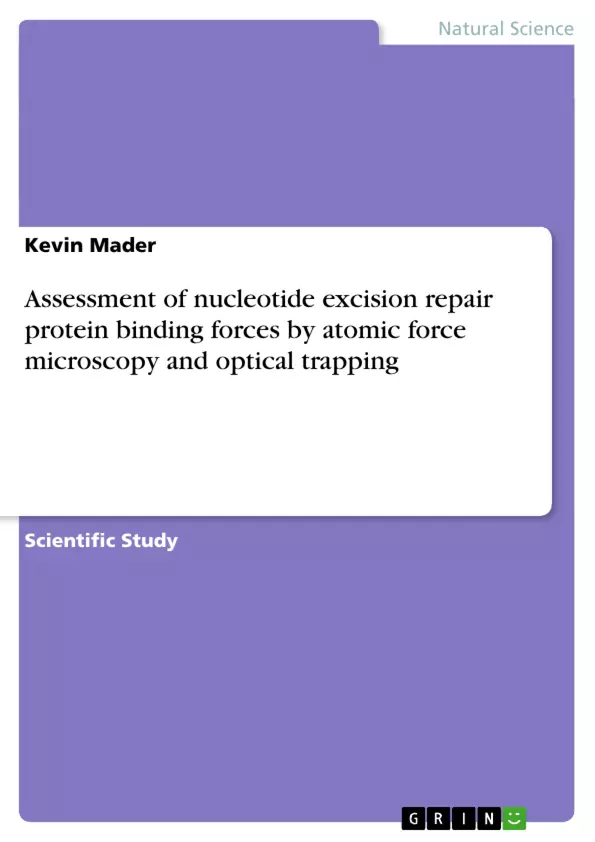DNA is under constant repair from the damage being done from sources such as UV radiation, mutagenic chemicals, and errors made by the cell's DNA replication mechanisms. The ability for a cell to identify and repair the damaged DNA is crucial for the cell to be able to successfully function and replicate. On a systemic scale the repair is essential for maintaining long term genomic stability. When these pathways fail the usual response is for the cell to die but in some instances the damage is done in a region that causes the cell to become carcinogenic. The DNA repair enzymes are responsible for finding and correcting these mistakes.
There are many different types of damage that can be done to DNA ranging from dimerization to depurination. Each of these types of damage requires a slightly different repair mechanism. The specific type of damage that is being investigated in this proposal is pyridine dimerization which usually occurs as the result of exposure to UV radiation. The repair pathway being nucleotide excision repair which involves either the replacement or removal of a region surrounding the damaged DNA. Problems in this pathway are important in pathological conditions such as xeroderma pigmentosum which causes the skin to be over sensitive to sun exposure and a high incidence of cancer.
Also genetic engineering utilizes deletion and insertion of DNA bases into various different cells. Understanding the pathways utilized to identify the structural changes that signify damage could be utilized to construct more sensitive repair proteins. Understanding the mechanisms of repair proteins to replace the damaged DNA with the correct segment could be utilized to develop faster more efficient ways for modifying bacteria and cells in beneficial ways.
Finally understanding the mechanisms of DNA damage and repair are useful from an evolutionary standpoint. For cells and organisms to be capable of genetic adaptations to environmental forces and consequently long term survival the repair mechanisms need to work well enough to keep the genome stable, but make mistakes often enough to allow for enough diversity for survival. The balance struck between these two goals is highly variant between species. A deeper understanding of the recognition and repair of damaged DNA could provide insights into the driving factors behind the evolutionary process
Inhaltsverzeichnis (Table of Contents)
- Introduction
- Specific Aims
- DNA-Protein Binding
- DNA Strength during UvrABC Binding
- Optical Tweezers
- Background and Significance
- Dimerization
- Preliminary Studies
- Force Spectroscopy
- Dynamic Force Spectroscopy
- DNA Stretching
- Groove Binding
- Research Design and Methods
- Sample Preparation
- DNA Damage
- DNA Damage Quantification
- Binding DNA to AFM Tip
- Binding DNA to Polystyrene Bead
- Protein Sample Preparation
- Binding Protein to Slide
- AFM Setup
- Optical Trapping Setup
- Expected Sources of Error
- Experimental Analysis
- DNA-Protein Rupture Forces
- Force Spectroscopy
- Sample Preparation
- Alternative Methods
- Scanning Probe
- Mutations
- Species of Protein
Zielsetzung und Themenschwerpunkte (Objectives and Key Themes)
This research program aims to investigate DNA repair proteins, specifically the UvrABC complex, by examining the binding force between the protein and damaged DNA molecules. The research utilizes atomic force microscopy (AFM) and optical trapping techniques to determine the strength of DNA-protein interactions. It also investigates how the DNA molecule's strength is affected during the repair process.
- DNA-protein binding forces
- DNA tensile properties during repair
- UvrABC complex structure and function
- Mechanisms of nucleotide excision repair
- Applications in genetic engineering and cancer treatment
Zusammenfassung der Kapitel (Chapter Summaries)
- Introduction: This chapter provides an overview of DNA repair mechanisms, emphasizing the importance of the UvrABC complex in repairing UV-induced damage. It highlights the significance of understanding these processes for various fields, including cancer treatment and genetic engineering.
- Specific Aims: This chapter outlines the three primary aims of the research project. These include determining the binding force of the UvrA and UvrB proteins to damaged DNA, measuring the tensile properties of DNA during repair by the UvrABC complex, and verifying results using optical tweezers.
- Background and Significance: This chapter focuses on the types of DNA damage, particularly UV-induced dimerization. It explains how this damage disrupts the DNA structure and hinders cellular processes.
- Preliminary Studies: This chapter provides a summary of previous studies related to force spectroscopy, dynamic force spectroscopy, DNA stretching, and groove binding.
- Research Design and Methods: This chapter details the experimental procedures, including sample preparation, AFM and optical trapping setups, and data analysis methods. It describes how different factors will be modulated in the experiments, such as the concentration of UvrABC complex and the rate of stage movement.
Schlüsselwörter (Keywords)
Key terms and concepts covered in this study include DNA repair, nucleotide excision repair, UvrABC complex, atomic force microscopy, optical trapping, DNA-protein interactions, binding forces, DNA tensile strength, UV damage, dimerization, genetic engineering, and cancer treatment.
- Citation du texte
- BS Kevin Mader (Auteur), 2007, Assessment of nucleotide excision repair protein binding forces by atomic force microscopy and optical trapping, Munich, GRIN Verlag, https://www.grin.com/document/75136



